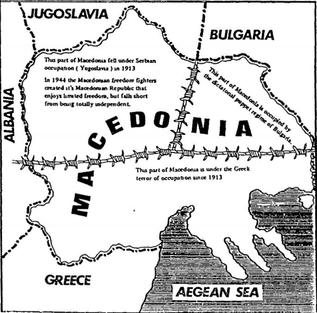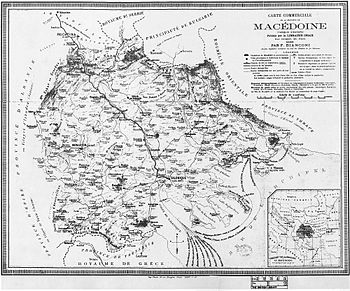This is an old revision of this page, as edited by Crossthets (talk | contribs) at 00:26, 24 September 2008 (FYROM nationalists try to downplay the significance but let Wikipedians decide). The present address (URL) is a permanent link to this revision, which may differ significantly from the current revision.
Revision as of 00:26, 24 September 2008 by Crossthets (talk | contribs) (FYROM nationalists try to downplay the significance but let Wikipedians decide)(diff) ← Previous revision | Latest revision (diff) | Newer revision → (diff)

United Macedonia (Macedonian: Обединета Македонија, Obedineta Makedonija) is an irredentist concept among ethnic Macedonian nationalists that aims to unify the transnational region of Macedonia in southeastern Europe, which they claim as their national homeland, and which they assert was wrongfully divided under the Treaty of Bucharest in 1913, into a single state under their rule with the Greek city of Thessaloniki (which they and other Slavs refer to as Солун, Solun) as its capital. The term has been in use since the early 1900s, notably in connection with the Balkan Communist Federation.
Although the following perception is not limited to ethnic Macedonians, or extreme nationalists, the majority of ethnic Macedonians usually break down the region of Macedonia as follows, a categorisation which is considered offensive by itself, by both Greeks and Bulgarians:
- Vardar Macedonia (Вардарска Македонија) - the Republic of Macedonia.
- Aegean Macedonia (Егејска Македонија) - the three Macedonian peripheries of northern Greece.
- Pirin Macedonia (Пиринска Македонија) - the unofficial name of Blagoevgrad Province in southwestern Bulgaria
- Mala Prespa and Golo Brdo (Мала Преспа и Голо Брдо) - an area in southeastern Albania corresponding roughly to the Korçë, Pogradec and Devoll districts (sometimes considered to be a part of Aegean Macedonia).
- Gora and Prohor Pchinski (Гора и Прохор Пчински) - in southern Kosovo and Serbia (these subregions are sometimes considered to be a part of Vardar Macedonia).
An essential aspect of this concept is the claim that the vast majority of the population in those territories are oppressed ethnic Macedonians and they describe those areas as the unliberated parts of Macedonia. In the cases of Bulgaria and Albania, it is said that they are undercounted in the censuses (In Albania, there are officially 5,000 ethnic Macedonians, whereas Macedonians nationalists claim the figures are more like 120,000-350,000 . In Bulgaria, there are officially, 5,071 ethnic Macedonians, whereas Macedonian nationalists claim 200,000 ). In Greece, there is a Slavic-speaking minority with various self-identifications (Macedonian, Greek, Bulgarian), estimated by Ethnologue, and the Greek Helsinki Monitor as being between 100,000-200,000 (according to the Greek Helsinki Monitor only an estimated 10,000-30,000 have an ethnic Macedonian national identity ). Macedonian nationalists have claimed that there is a Macedonian minority numbering up to 800,000 .
The roots of the concept can be traced back to 1910. One of the main platforms from the First Balkan Socialist Conference in 1910 was the solution to the Macedonian Question, Georgi Dimitrov in 1915 writes that the creation of a "Macedonia, which was split into three parts, was to be reunited into a single state enjoying equal rights within the framework of the Balkan Democratic Federation"
The concept about United Macedonia was used by revolutionaries from the Internal Macedonian Revolutionary Organization (IMRO) too. In 1920-1934 their leaders - Todor Alexandrov, Alexandar Protogerov, Ivan Mihailov, etc., accept this concept with the aim to liberate the territories occupied by Serbia and Greece and to create Independent and United Macedonia for all Macedonians - Bulgarians, Greeks, Serbians, Albanians, etc.
The idea of reunification of all of Macedonia under Communist rule was abandoned in 1948 when the Greek Communists lost in the Greek Civil War, and Tito fell out with the Soviet Union and pro-Soviet Bulgaria.
Before and just after the Republic of Macedonia's independence, it was assumed in Greece that the ideology of a United Macedonia was still state-sponsored. In the first constitution of the newly independent Republic of Macedonia, adopted on 17 November 1991, Article 47 read as follows :
- (1) The Republic cares for the status and rights of those persons belonging to the Macedonian people in neighboring countries, as well as Macedonian expatriates, assists their cultural development and promotes links with them. In the exercise of this concern the Republic will not interfere in the sovereign rights of other states or in their internal affairs.
- (2) The Republic cares for the cultural, economic and social rights of the citizens of the Republic abroad.
This was seen in Greece as a declaration of a right to interfere in Greece's internal affairs.
Finally, on 13 September 1995, the Republic of Macedonia signed an Interim Accord with Greece in order to end the economic embargo Greece had imposed, amongst other reasons, for the perceived land claims. Amongst its provisions, the Accord specified that the Former Yugoslav Republic of Macedonia (as it was known) would renounce all land claims to neighboring states' territories.
The concept is still widely known and espoused by Macedonian nationalists. In 2008 Prime Minister Nikola Gruevski was photographed leaving a wreath with a large image of "United Macedonia" directly in front of him.

The United Macedonia concept is still found among official sources in the Republic, and taught in schools through school textbooks and through other governmental publications.
See also
- Macedonia (terminology)
- Demographic history of Macedonia
- Internal Macedonian Revolutionary Organization
- History of the Republic of Macedonia
- Macedonism
- The Ten Lies of Macedonism
- Titoism
References
- Including but not limited to ethnic Macedonians, Bulgarians, Slovenes, Croats, Serbs, Czechs and Slovaks
- ^ Greek Macedonia "not a problem", The Times (London), August 5 1957 Cite error: The named reference "Times" was defined multiple times with different content (see the help page).
- ^ See Cite error: The named reference "Albania" was defined multiple times with different content (see the help page).
- ^ See . Cite error: The named reference "Bulgaria" was defined multiple times with different content (see the help page).
- See .
- ^ Patrides, Greek Magazine of Toronto, September - October, 1988, p. 3. Cite error: The named reference "Patrides" was defined multiple times with different content (see the help page).
- Constitution of the Republic of Macedonia, adopted 17 November 1991, amended on 6 January 1992.
- "Interim Accord between the Hellenic Republic and the former Yugoslav Republic of Macedonia", United Nations, 13 September 1995.
- Prime Minister Nikola Gruevski knelling in front of image of "Greater Macedonia "
- Simons, Marlise (February 3 1992). "As Republic Flexes, Greeks Tense Up". New York Times.
{{cite news}}: Check date values in:|date=(help) - "Makedonija — General Information".
{{cite web}}: Unknown parameter|accessmonthday=ignored (help); Unknown parameter|accessyear=ignored (|access-date=suggested) (help) - Danforth, Loring M. How can a woman give birth to one Greek and one Macedonian?. Retrieved 2006-12-26.
{{cite book}}:|work=ignored (help) - "The vision of "Greater Macedonia"".
{{cite web}}: Unknown parameter|accessmonthday=ignored (help); Unknown parameter|accessyear=ignored (|access-date=suggested) (help) - "The vision of "Greater Macedonia"". Specific examples (I).
{{cite web}}: Unknown parameter|accessmonthday=ignored (help); Unknown parameter|accessyear=ignored (|access-date=suggested) (help) - "The vision of "Greater Macedonia"". Specific examples (II).
{{cite web}}: Unknown parameter|accessmonthday=ignored (help); Unknown parameter|accessyear=ignored (|access-date=suggested) (help) - The Macedonian Times, semi-governmental monthly periodical, Issue number 23, July-August 1996:14, Leading article: Bishop Tsarknjas
- Facts About the Republic of Macedonia - annual booklets since 1992, Skopje, Republic of Macedonia Secretariat of Information, Second edition, 1997, ISBN 9989-42-044-0. p.14. 2 August 1944.
- MIA (Macedonian Information Agency), Macedonia marks 30th anniversary of Dimitar Mitrev's death, Skopje, February 24 2006
- "Official site of the Embassy of the Republic of Macedonia in London". An outline of Macedonian history from Ancient times to 1991. Retrieved 2006-12-26.
- Society for Macedonian Studies, Macedonianism FYROM'S Expansionist Designs against Greece, 1944-2006, Ephesus - Society for Macedonian Studies, 2007 ISBN 978-960-8326-30-9, Retrieved on 2007-12-05.